
In retail, every minute counts. Efficient maintenance management is essential to ensure that shops operate without disruption. Technical problems, such as failures in the air conditioning system or security equipment, can directly affect the customer experience, resulting in lost sales and reputation.
Proper maintenance not only improves operability, but also has a direct impact on the profitability of the business. With proactive management, it is possible to prevent incidents from becoming major problems.
Key factors of efficient maintenance management:
- Rapid resolution of incidents to avoid downtime.
- Preventivemaintenance to avoid problems before they occur.
- Optimisation of resources to ensure the proper functioning of the facilities.
How technology solutions optimise shop maintenance

Technology has become an essential ally in optimising retail maintenance. With digital platforms, maintenance can be managed in a more efficient and coordinated way, reducing response times and improving service quality.
These tools enable centralised incident management, making it easy for employees to report incidents in real time. This improves efficiency and reduces the risk of problems remaining unresolved.
Advantages of using technological solutions:
- Processautomation for more agile management.
- Centralisation of information for more effective control.
- Improved response times thanks to integration with suppliers.
The role of digital platforms in improving operational efficiency

Digital platforms not only manage incidents, they also enable full integration with other operational processes. This facilitates seamless coordination between departments and ensures that all aspects of the shop are running smoothly.
With tools like these, companies can manage multiple tasks from a single point, reducing errors and improving productivity. In addition, they allow detailed tracking of each maintenance request , optimising resources.
Key benefits of digital platforms:
- Real-timevisibility of all incidents.
- Efficientcoordination between different departments and suppliers.
- Greater control over operational processes.
Benefits of implementing technology in incident management in retailing

Implementing technology solutions in incident management not only improves efficiency, but also contributes to a number of tangible benefits:
- Reducing operating costs by automating manual tasks.
- Improved customer experience by ensuring a seamless environment.
- Time optimisation by eliminating inefficient processes.
Business impact:
- Significant savings in time and resources.
- Improved customer service through continuous operation.
- Reducing repair costs with preventive maintenance.
How to reduce operating costs with proactive maintenance

Proactive maintenance is key to reducing long-term costs. Instead of waiting for incidents to occur, companies can use technology to continuously monitor shop systems and anticipate potential problems.
Implementing preventive maintenance ensures that shops operate smoothly and prolongs the life of equipment.
Strategies for proactive maintenance:
- Constantmonitoring of systems to detect failures before they occur.
- Planning preventive repairs based on historical data.
- Resource optimisation by prioritising the most critical tasks.
This approach not only avoids disruptions, but also improves operational efficiency, resulting in savings and a more cost-effective operation.
In short, efficient maintenance management in retail shops is essential to ensure business continuity and customer satisfaction. Implementing technological solutions allows optimising all processes, reducing costs and improving the experience at each point of sale. With a proactive approach and the use of digital platforms, businesses can ensure smooth and efficient operations, minimising downtime and maximising profitability.


